Are you having a grease gun at your disposal and trying to understand its operation? This may perhaps be your first attempt at using one and it might come across as unfamiliar.
Don’t worry because equipping yourself with the right knowledge and skills could be very useful when dealing with this challenging task.
Fortunately, you have found this article which will help you:
- Get to know grease guns on a fundamental level
- Provide the step-by-step process of using such tools
So take your grease gun and read on!
How does a grease gun work?
All following types of grease guns have the same general principles in use and parts. They use pressure to drive grease out through a nozzle to apply on mechanical parts. However, each one differs in how you handle them, specifically how pressure is produced and applied. Regardless, knowing how to operate one of them would be enough for you to handle other grease guns.
Manual grease gun
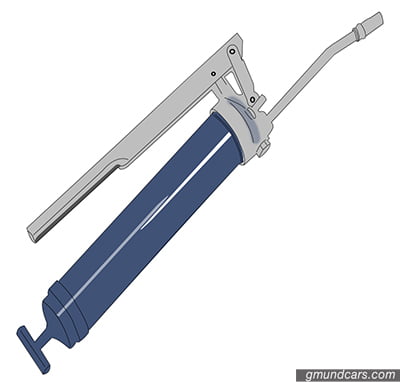
The pressure for manual grease guns comes from either a trigger mechanism for pistol-gripped guns or cranking action for lever types. After loading the grease gun’s barrel with the appropriate kind of lubricant, manually apply the pressure by hand.
Manual grease guns are the cheapest and widely used type, but using them could be a strenuous activity, especially for prolonged periods of continuous use.

Best pistol grip grease gun

Best lever grip grease gun
Pneumatic grease gun
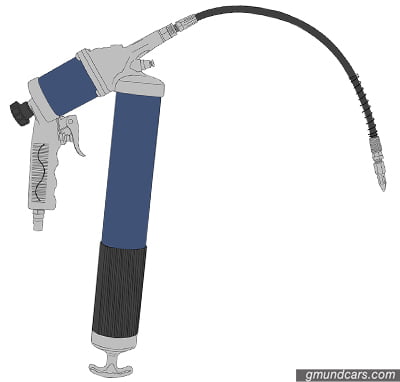
Air-powered grease guns use compressed air delivered by electric-powered or gas-powered compressors through hoses. These guns create a steady flow of air pressure, which forces the lubricant out of couplers into fittings. When pushing the trigger, you dispense a consistent flow of lubricant without straining yourself.
However, pneumatic grease guns would require you to have a functioning compressor on hand to use them.

Lincoln 1162
Best pneumatic grease gun
Electric grease gun
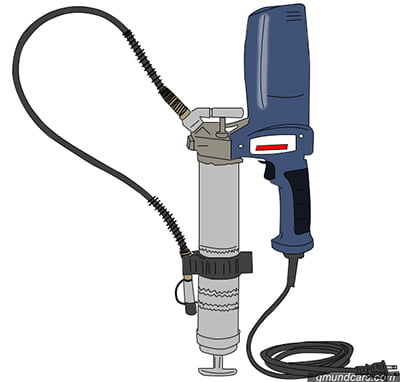
Electric grease guns use powerful motor drives to deliver lubricants and are the most common alternative to air-powered counterparts. They are corded tools that you need to plug into an appropriate and uninterrupted power source to use continuously. Like the pneumatic grease gun, you apply the lubricant by pressing the trigger.
Battery-Powered grease gun

Battery-powered grease guns are operated the same as electric ones. The only difference is that they are cordless and should be charged before use. You could easily transport them as you would with manual grease guns, carrying tasks much faster.
Now you might wonder what type of grease you should use and how to load them in grease guns. Hardware stores provide all kinds of grease but do not worry, as there are already available pre-refilled cartridges that make it easier to load. In the next part of the article, you would learn how to load lubricant into a grease gun.

Best 18V cordless grease gun

Best 20V cordless grease gun
How to use a grease gun
How to load a grease gun with a cartridge
Using pre-filled cartridges to load a grease gun is the fastest and simplest way, which leaves the mess out and is easy to dispose of when it runs out.
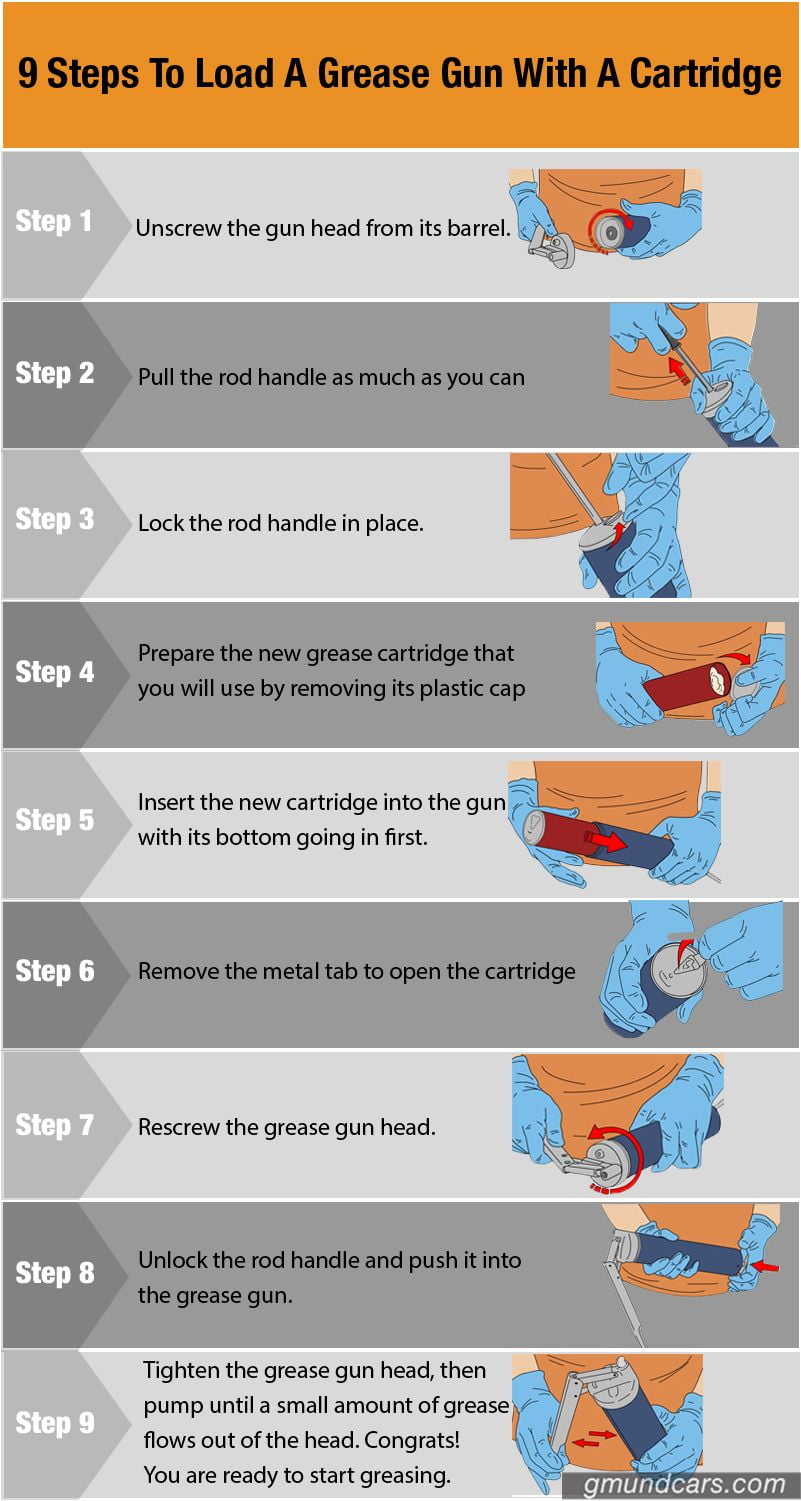
Step 1: Unscrew the gun head from its barrel.
Step 2: Pull the rod handle as much as you can.
Step 3: Lock the rod handle in place.
Step 4: Prepare the new grease cartridge that you will use by removing its plastic cap.
Step 5: Insert the new cartridge into the gun with its bottom going in first.
Step 6: Remove the metal tab to open the cartridge.
Step 7: Reattach the grease gun head. Make sure to leave some space to allow air to escape.
Step 8: Unlock the rod handle and push it into the grease gun.
Step 9: Tighten the grease gun head, then pump until a small amount of grease flows out of the head. Congrats! You are ready to start greasing.
How to load a grease gun without a cartridge
Loading a grease hun without using a cartridge can save you a few dollars. For this, you would need a tub of grease and read the guide below:
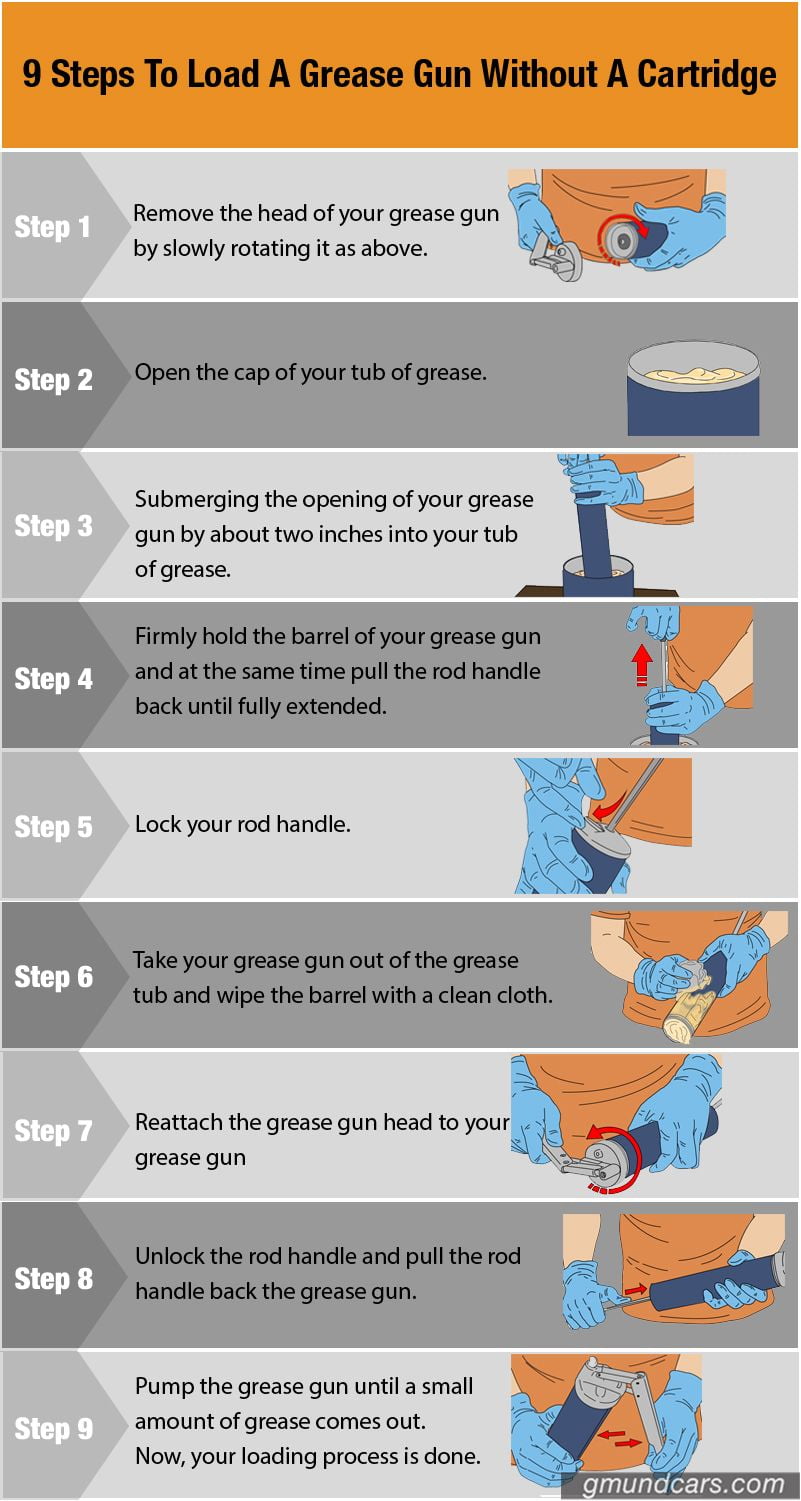
Step 1: Remove the head of your grease gun by slowly rotating it.
Step 2: Open the cap of your tub of grease.
Step 3: Submerging the opening of your grease gun by about two inches into your tub of grease.
Step 4: Firmly hold the barrel of your grease gun and at the same time pull the rod handle back until fully extended
Step 5: Lock your rod handle.
Step 6: Take your grease gun out of the grease tub and then wipe the barrel with a clean cloth.
Step 7: Reattach the grease gun head to your grease gun.
Step 8: Unlock the rod handle and push the rod handle back into the grease gun.
Step 9: Pump the grease gun until a small amount of grease comes out. Now, your loading process is done.
How to load a grease gun with a bulk fill pump
There is another way to load a grease gun without using a cartridge besides bulk filling via suction. This method uses a bulk filling with a manual pump through an attached filler nipple on the grease gun.

Step 1: Insert the nipple into the bulk filler’s coupler, then press down to open the valve.
Step 2: Begin pumping lubricant into the gun for a few cycles. After that, stop to ensure that the rod is engaged to the follower to help you identify the grease level in the barrel.
Step 3: Stop pumping when the locking rod notch and the in-cap notch line up. Twist the t-handle and slide it into the barrel.
Step 4: Now your grease gun is filled and ready for use.
How to bleed a grease gun
If you are having trouble pumping grease out of the grease gun, most of the time, the air is trapped inside. This is where “bleeding” your grease gun comes in. Bleeding a gun means releasing the air out from an air bleed valve attached to your grease gun. It prevents airlocks and makes sure that the gun works smoothly.
Here are tips on how you can bleed a grease gun:
When you unscrew the barrel back by a little bit, it will create more airspace. Loosening the tube would help you to bleed out the air, as it would produce more pressure.
When finishing loading a grease gun, remember to press the air valve on top of the gun to bleed the air out.
Simple to bleed your grease gun, right? This bleeding will make your job easier no matter what types of grease guns you use.
How to apply a grease gun
After knowing how to load and bleed a grease gun appropriately, the best part of using a grease gun is its application in machinery. Follow these six quick steps on how to apply grease properly:
Check work order
Select a target location to apply the grease. Targeting a specific spot instead of applying grease to all parts of a mechanism ensures efficiency when using the grease. Determine the amount of grease required per area and the type of grease necessary for the job. Checking the work order ensures that you do not waste any lubricant; you save time and complete tasks quickly.
Pre-clean and double-check
Use a clean, lint-free cloth to clean grease fittings before greasing. A lint-free cloth does not shed fabric fibers, which could clog and cause wear on the grease gun overtime. Besides, you could use disposable lint-free paper-based products to pre-clean the fittings.
Double-check to see if the grease gun is functioning correctly, as grease needs to flow consistently and smoothly so you could apply the grease accurately.
Prepare gun for greasing
Properly load the gun and bleed out air trapped at the top of the gun before attempting to use it. Attach a tube with a nozzle on the gun’s head for hard-to-reach areas.
Calibrate the grease gun
Calibrate your grease gun by measuring the amount of grease produced per pump or by slowly squeezing the trigger. If you have one, use a scale to measure the output accurately which will give you an idea of how much grease you would need to apply.
Prime the grease gun by pumping it a few times until grease comes out.
Apply the grease
Now you can apply the grease to your machines. Place the lubricant onto the designated areas as needed. For bearing cavities, connect the nozzle to the nipple and fill the void until you feel a slight resistance against the lever or trigger. The resistance means that the cavity is now full, and you can disengage the nozzle from the nipple carefully.
However, make sure not to overdo the filling procedure as it could damage the machine or even cause injury.
Post-clean
After the filling process, wipe off any residual grease from the nozzle and fitting using a lint-free cloth or paper-based products. Store the grease gun with the barrel bottom pointing downwards, then put the barrel cap back.
Grease gun tips
As simple as grease guns may seem to operate, they still deserve respect and should be used and cared for following guidelines. On their own, grease guns are already equipped with safety devices to avoid injuries. However, their effectiveness depends on your understanding.
Personal safety
As with any equipment, hardware, or tool handling with moving parts, it is always in your best interest to look out for your personal safety:
- Wear personal protective equipment such as gloves, safety glasses, safety sleeves, and non-skid boots to prevent injuries.
- Another thing when handling grease guns is to always stay on alert. Like any other tool, never operate when you are physically and mentally incapable.
- Ensure you are not wearing anything loose such as jewelry or torn clothing that may get caught in moving parts.
- Always follow procedure, training, and appropriate tool maintenance to keep you safe and your grease gun live longer.
Work area safety
Maintaining good upkeep of your surroundings is extremely crucial when using these tools:
- Keep your work area clean and uncluttered to avoid accidents.
- Clean spills immediately using granules or absorbent drying pads, which soak up the grease effortlessly.
- Sometimes wiping would not be enough, so it is suggested to wash the area with warm water and bleach.
- Stay away from open flames, as most lubricants are flammable and susceptible to fire. Check for open flames or sparks before starting to work with grease.
- Minimize distractions and always keep your work area well lit.
Grease gun maintenance
Before using grease guns, it is only right for you to know how to maintain them well. Here are five excellent quick tips for you to keep grease guns properly functioning with repeated use:
- Never mix the old grease with the new grease. Different grease guns use grease compatible with them. However, if you use only one type of grease gun, ensure to clean it thoroughly before loading it with a new lubricant.
- Double-check the grease guns’ fitting first for damages or any issue to save you the trouble of having malfunctions when using them.
- Clean the grease gun after every use. Cleaning your tools would not only extend their lifespan but also save you the trouble when using them. Do not let old grease sit in the grease gun for too long. Wash with warm water and let dry for best results.
- Avoid tightening the head of the grease gun too much. Excessive pressure could damage or destroy bearing shields or seals, leading to malfunction and could create pressure failure.
- Never let your tools get wet for prolonged periods to avoid rust and dust from collecting.
FAQs
Q. How do you know when a grease gun is empty?
A. Just pull out the t-handle until you hit the follower plate inside the barrel, which pushes the grease. The length of the rod sticking out tells you how much grease is left. Therefore, when you pull the handle, and no rod is coming out, it means your grease gun is empty.
Q. Why does my grease gun leak?
A. Grease could leak from grease guns when constant pressure is applied to them by the follower plate. Grease is a combination of oil and a thickener, which separates when not used for a long time. When exposed to continuous pressure and hot temperatures, the oil finds its way out, usually leaking at the bottom of the gun.
Q. How do you stop a grease gun from leaking?
A. Most grease guns, depending on the quality, leak over time, and there is not much you can do about it. However, you can minimize the mess it creates by placing a catch bin under the grease gun when you store it. You could also use a barrel cap, which catches leaks and drips coming out from the gun’s bottom.
Q. How much grease comes out of a grease gun?
A. Usually, a lubricant shot dispenses varying amounts of grease subject to the grease gun’s size, condition, and model. They typically range from 0.5 grams to more than 3 grams per pump.
Q. Why does my grease gun not work?
A. The most common reason for your grease gun not working is the trapped air at the top of the gun. You could quickly fix the issue by following the proper steps on how to bleed a grease gun in this article
To sum up
Machines with moving parts require lubrication to increase their working performance and extend their life. Therefore, knowing how to apply grease is an essential job, especially if you own machinery.
After reading this article, you now become fully skilled at loading, bleeding, using, and maintaining a grease gun. So what are you waiting for? Get your grease gun and start lubricating!

Wow thanks to those 9 steps and 4 steps pictures, I could much much more easily understand how to use the gun. I can be a handy man myself. I will read rest of stories too. Great job.